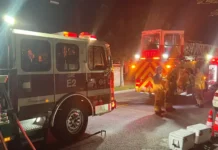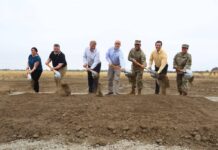story by Staff Sgt. Crystal Housman
California National Guard Public Affairs
LOS ALAMITOS, Calif. – A group of teenage rocket scientists from STARBASE Los Alamitos will make their second successive appearance in The American Rocketry Challenge National Finals as they travel to Lucerne Dry Lake this weekend to launch a rocket they’ve spent nearly two years designing and testing.
The team, made up middle and high school students who live near Joint Forces Training Base, Los Alamitos, and practice on the installation, earned a place in the finals by scoring among the top 100 teams nationwide with their qualifying launches in early May.
“I’m so proud of these guys,” said STARBASE teacher and rocketry coach Tim Ziesmer, after the team launched two rockets within the competition’s targeted time duration and each within 10 feet of a specified launch altitude.
“They’re more organized, tighter, and more focused,” Ziesmer said, comparing this year’s team to previous years. “We have a lot more practice and more experience under our belts.”
The challenge tests a team’s ability to meet particular engineering requirements along with specific launch parameters while assessing points for going over or under a targeted flight time and launch height. The lowest score wins.
“I’m pretty happy with today. I’m really happy with our score,” said fourth year team member and high school freshman Emily Rodeghiero after the team submitted two 10-point qualifying launches.
“We definitely have to work on our parachute,” she said, after tangled parachute lines caused one practice launch to fly outside of the competition’s zero-point time window.
The rocketry program at STARBASE Los Alamitos began four years ago, and each year the team makes technological improvements in its design and build. This year is no different.
“They found a place to get carbon fiber fabric [for the body] and we figured we could do it,” Ziesmer said. “It’s a commitment, though, because you have to make everything. There are no more off-the-shelf parts.”
The teens used simulation software to design a rocket with a carbon fiber body and laser cut fins and other parts from aircraft-grade wood. They used a 3-D printer to create a nose cone and other parts, as needed.
The new design is a lightweight rocket that gives the team a wider latitude to add or subtract weight depending on launch day weather conditions.
Each launch also includes the weight of one egg, which must return intact with no visible cracks.
STARBASE Los Alamitos is one of four Department of Defense STARBASE locations in California and one of two operated by the California Military Department’s Task Force Torch. The program focuses on promoting science, technology, engineering and math to elementary students while also offering STARBASE 2.0 extracurricular opportunities for middle and high school students.
While most of the team is returning from previous years, David Asraf is competing for the first time. Last summer, the Los Alamitos High School freshman asked his mother for help finding extracurricular activities.
“She found this rocketry program on the military base, and I was like ‘that’s cool,’” he said. “I went here and checked it out and I really liked it.”
The American Rocketry Challenge is the world’s largest rocket contest with nearly 5,000 students nationwide competing each year. The contest gives middle and high school students the opportunity to design, build and launch model rockets and hands-on experience solving engineering problems.
The competition’s top team will receive $20,000 in prize money with an additional $1,000 presented to the team’s school site. Additional prize money will be awarded to the 2nd-5th place teams, nationally, along with $1,000 presented to the lowest scoring team at each national finals launch location.
STARBASE Los Alamitos earned its first national finals appearance in 2019, traveled to Virginia and placed 51st overall. The team flew practice launches in 2020, however the national finals were suspended due to the COVID-19 pandemic.
This year marks their return to the national stage and an opportunity to compete in Southern California amid continued pandemic safety precautions.
The original story was originally published on the Defense Visual Information Distribution Service (DVIDS) website.












